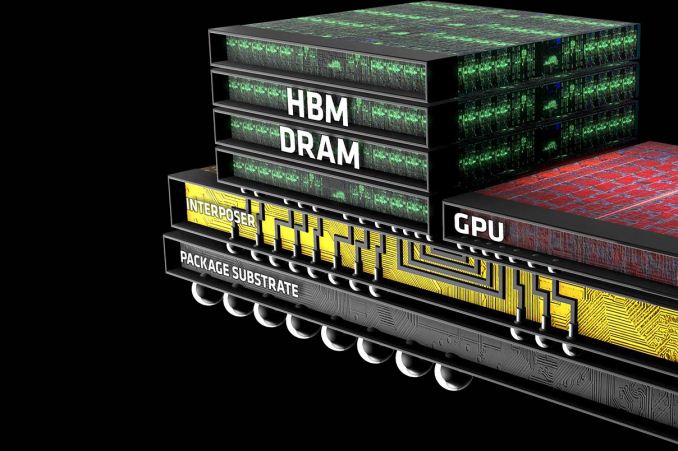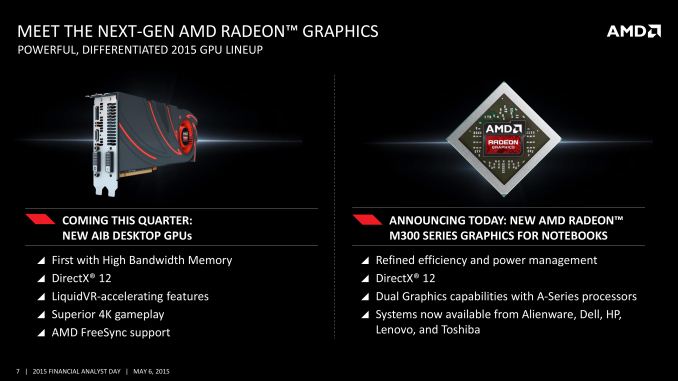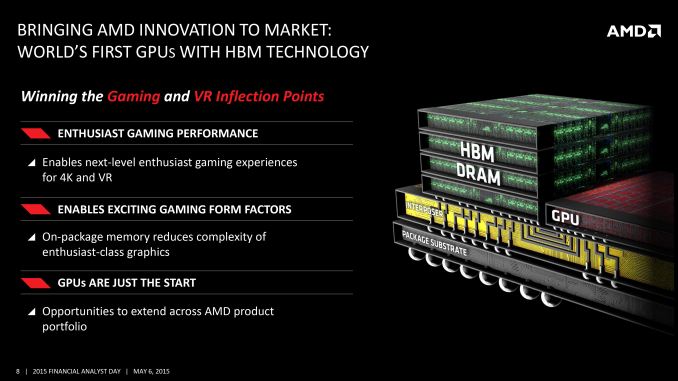AMD Dives Deep On High Bandwidth Memory - What Will HBM Bring AMD?
by Ryan Smith on May 19, 2015 8:40 AM EST
Though it didn’t garner much attention at the time, in 2011 AMD and memory manufacturer Hynix (now SK Hynix) publicly announced plans to work together on the development and deployment of a next generation memory standard: High Bandwidth Memory (HBM). Essentially pitched as the successor to GDDR, HBM would implement some very significant changes in the working of memory in order to further improve memory bandwidth and turn back the dial on memory power consumption.
AMD (and graphics predecessor ATI) for their part have in the last decade been on the cutting edge of adopting new memory technologies in the graphics space, being the first to deploy products based on the last 2 graphics DDR standards, GDDR4, and GDDR5. Consequently, AMD and Hynix’s announcement, though not a big deal at the time, was a logical extension of AMD’s past behavior in continuing to explore new memory technologies for future products. Assuming everything were to go well for the AMD and Hynix coalition – something that was likely, but not necessarily a given – in a few years the two companies would be able to bring the technology to market.

AMD Financial Analyst Day 2015
It’s now 4 years later, and successful experimentation has given way to productization. Earlier this month at AMD’s 2015 Financial Analyst day, the company announced that they would be releasing their first HBM-equipped GPU – the world’s first HBM-equipped GPU, in fact – to the retail market this quarter. Since then there have been a number of questions of just what AMD intends to do with HBM and just what it means for their products (is it as big of a deal as it seems?), and while AMD is not yet ready to reveal the details of their forthcoming HBM-equipped GPU, the company is looking to hit the ground running on HBM in order to explain what the technology is and what it can do for their products ahead of the GPU launch later that quarter.
To date there have been a number of presentations released on HBM, including by memory manufactures, the JEDEC groups responsible for shaping HBM, AMD, and even NVIDIA. So although the first HBM products have yet to hit retail shelves, the underpinnings of HBM are well understood, at least inside of engineering circles. In fact it’s the fact that HBM is really only well understood within those technical circles that’s driving AMD’s latest disclosure today. AMD sees HBM as a significant competitive advantage over the next year, and with existing HBM presentations having been geared towards engineers, academia, and investors, AMD is looking to take the next step and reach out to end-users about HBM technology.
This brings us to the topic of today’s article: AMD’s deep dive disclosure on High Bandwidth Memory. Looking to set the stage ahead of their next GPU launch, AMD is reaching out to technical and gaming press to get the word out about HBM and what it means for AMD’s products. Ideally for AMD, an early disclosure on HBM can help to drum up interest in their forthcoming GPU before it launches later this quarter, but if nothing else it can help answer some burning questions about what to expect ahead of the launch. So with that in mind, let’s dive in.
I'd also like to throw out a quick thank you to AMD Product CTO and Corporate Fellow Joe Macri, who fielded far too many questions about HBM.











163 Comments
View All Comments
jardows2 - Tuesday, May 19, 2015 - link
The open-air problem is only a problem if there is a new, smaller form factor for the video cards. OEM partners will likely make oversized heatsinks, or use a custom PCB to support more fans, just as they do now. With the reduced power envelope, I imagine the bulk of the OEM's will use the savings to make more compact designs, rather than use the energy savings to make higher performing designs.xenol - Tuesday, May 19, 2015 - link
I'm a bit skeptical that HBM will dramatically increase the performance the GPU. While it's true that this will help with high resolution rendering, there's also the fact that if the GPU wasn't up to snuff to begin with, it doesn't matter how much memory bandwidth you throw at it. But I'm willing to wait and see when this tech finally shows up at our store shelves before committing to any idea.If anything, I'm only led to believe this will just solve memory bandwidth and power consumption issues for a while.
testbug00 - Tuesday, May 19, 2015 - link
It won't on 28nm. Give you higher core clocks in a TPD, yes. HBM currently shows bandwidth scaling to at least 8TB/s from what I can tell... Which, is over 20 times the Titan X currently. Even if they can "only' hit half of that, it should supply more than enough bandwidth until 5nm process at least.So, at least 10 years, more likely 15-20.
chizow - Tuesday, May 19, 2015 - link
I agree, it is interesting though regardless, as 2.5D stacked RAM is clearly going to be the future of GPU memory, which will in turn drive different form factors, cooling solutions etc.der - Tuesday, May 19, 2015 - link
It'll bring a lot!guskline - Tuesday, May 19, 2015 - link
Great article. Sounds like custom water coolers may be shut out because the OEM cooler will be water cooled and there probably isn't enough improvement going to custom cooling.I'm anxious to see the performance of a single 390x Fiji vs my 2 custom cooled R9 290s in CF.
CaedenV - Tuesday, May 19, 2015 - link
This is fantastic. I mean, we cannot build any wider, so it is neat to see them finding ways to build upwards instead.I would love to see a next gen device that pairs a card like this with HMC. Super fast mixed-use storage/memory combined with super fast GPU memory would make for a truly amazing combination.
Also, I don't see the 4GB limit being a big deal for mainstream high-end cards or laptops. It is only the ultra high-end enthusiast cards that might suffer in sales.
menting - Tuesday, May 19, 2015 - link
Just to be clear..HBM and HMC are not the same (but they are fairly similar in a lot of areas)anubis44 - Tuesday, May 19, 2015 - link
nVidia also simply has fewer good, long-term relationships to exploit than AMD has. The whole semi-conductor industry has been working with AMD for 45 years, whereas nVidia, run by Jen Hsun Huang, a former AMD employee, has only been around for about 15 years.HighTech4US - Tuesday, May 19, 2015 - link
What drugs are you on today?